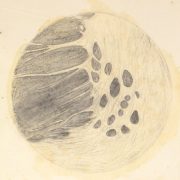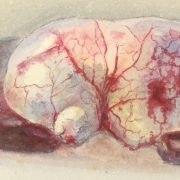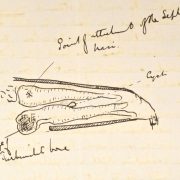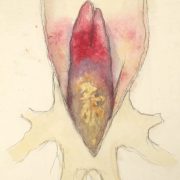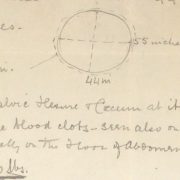FS/2/2/2/1/5 – Selected papers from veterinary case notes relating to the Nervous System
This material is Crown copyright, and contains public sector information licensed under the Open Government License v.3.0.
Click here for full transcript of Case Notes for Horse A6
[FS/2/2/2/1/5]
[[1]]
12th Royal Lancers
Station: Bangalore
Date: 1882
Troop: A
Number of Horse: 6
Sex: M
Age: 4
Disease: Epilepsy
Date of Admission: 23 Sept
Date of Discharge: 10 Nov
Result: Relieved
Record of the Case
23 Sept
Epilepsy. Called suddenly to the lines to see this horse at 6 pm. found her down, in a highly nervous state, eyeballs rolling, head rocking from side to side, pulse weak, got her up after a lot of trouble, and walked her to the sick lines. She was then paralyzed behind, & leaned all over to the left side. Placed in slings. Administered aloes ℨV Mustard to the loins.
24th [Sept]
Better. Eyeballs less off rolling, not so much nervousness. Leaning over to the same side in the slings.
Apply Ammonia to the loins. Not purging, repeat the aloes. The Sp. Gr. of the urine is very high 10.52 owing to phosphate lime[?].
26th [Sept]
Continues to improve. Stood out of the slings all day. Sp. Gr. Urine 10.50
5th Oct
Urine changed colour from a yellowish white to red.
No deposit of lime. Sp. Gr. 1052
14th [Oct]
Took out of slings permanently. Continued rest
25th [Oct]
Send to the troop lines for rest, being now perfectly convalescent. There is the least suspicion of unsteadiness in the hindquarters.
10th Novbr
Moves perfectly. To remain unmounted for three months, as a precautionary measure.
Discharged, Relieved
[Transcription by Claudia Watts, KCL History, April 2019]
Click here for full transcript of Case Notes for Horse belonging to Colonel Dawson
[FS/2/2/2/1/5]
[[1]]
Colonel Dawson’s Horse
July 20th 1889
Admitted to infirmary stables at 5 pm exhibiting colicy pains. Gave drench, Spl (Aumm Aro) ℨj,
Spl Nit Ether ℨj, Tinct Opii ℨj. Water 1 pint. Gave enema and sent to walking exercise. Passed some dung with enema & a lot while at exercise.
6 p.m – Appeared a little easier, repeated Drench & enema, exercise
7 p.m Decidedly worse. Gave aloes ℨV in solution, Amm Carb ℨij & Ginger ℨiij in ball. Hot fomentations to abdomen.
10 p.m Suffering great pain, passed the catheter & emptied bladder, continued hot rugs to abdomen every ¼ hour. Gave Lig Ext Can Indica ℨijss, also Amm Carb ℨss in ball. Constant enemas.
11-30 p.m. Gave Ext Can lndica ℨj. Continued hot rugs & enemas, passed nothing. Continually walking round box
July 21st
Repeated Ext Can ludica, began to get sleepy
1-30 a.m. Lay down & was very quiet
10-15 a.m. Pulse scarcely perceptible, like a bit of cotton, passed catheter & emptied bladder. Gave one dose of Physostigmine, in ¼ hour began to pass wind & a little mucous, but no dung passed yet. Pulse improved wonderfully. Hot rugs and enemas.
1 p.m Repeated Ext Can Indica. Hot rugs and enemas, lay down a little, then got up and stood very quiet for 2 hours. Took off wet rug, dried abdomen and applied Liniment. Drank water several times. Passed nothing yet.
11 p.m. Standing very quiet. Gave Linseed oil 1 pint.
July 22nd
Lay down, very quiet
2 am
[[2]]
4 a.m. Got up & staled well.
6 [a.m.] Staled again.
7 [a.m.] Drank some water, gave enema, nothing passed.
9 [a.m.] ¼ hour exercise. Good pulse.
11 [a.m.] [1/4 hour exercise.] Continued enemas
4 p.m. Gave enema, brought away a little dung, ¼ hour exercise, as soon as he came in he passed some dung.
5.30 p.m Gave enema, passed some more dung
July 23rd, 7 a.m Gave enema, brought away a lot of dung, ¼ hour exercise
9.30 a.m. Gave bran mash which he very soon eat.
1 p.m. Gave enema, brought away some dung & during the afternoon he passed some himself.
6.30 p.m Began to purge & purged well all night
July 24th Doing well, still purging, keep warm, bran mashes.
[July] 25th Doing well, dung setting.
[July] 26th Doing well. Half diet.
[July] 27th [Doing well, Half diet]
[July] 28th [Doing well], ¾ diet, ½ hour Exercise daily
[July] 30th Full diet
August 1st Discharged Cured
[Transcription by Claudia Watts, KCL History, April 2019]
Click here for full transcript of Case Notes for Horse Y16
12th Royal Lancers
Station: Bangalore
Date: 1882
Troop: Y
Number of Horse: 16
Sex: G
Age: 6
Disease: Paraplegia
Date of Admission: 25 March
Date of Discharge: 30 March
Result: Died
Record of the Case
25th March
Paraplegia. This horse was admitted with a slight attack of colic yesterday. This morning on coming out of the box he was noticed to crop his hind leg, rolling unsteady gait & every symptom of paraplegia. Has control over bladder and rectum. Clipped spine & applied a severe blister. Gave internally Aloes ℨV, Constant enema & place in slings
26th [March] No change, blister has not taken, put on sheep skin.
27 [March] Worse & very unsteady in slings, rolls from side to side, a touch of the hand pushes him over. Give Linc: Ergot Cure. Pot Iodid ā ā ℨy to indic put on another sheep skin & re-blister. Has control over the sphincter.
28th [March] – Worse Slumping throwing so much weight into slings & sitting down, that I had to let him out of them. Continue Ergot, & foment loins
6 p.m. Struggles very slightly, but I have no hope for him
29th [March] No change except perhaps for the worse
30th [March] Remains same. No power whatever. Pulse fairly good, give aloes ℨy as the bowels are not acting. Patient feeds well. Fired[?] back as a last resort & blistered it again.
4.30 p.m. – Died rather suddenly. P.M examination revealed lungs congested. Heart filled with fibrous clots, (cause of death), Liver intensely congested. Kidneys
[[2]]
congested. Intestines healthy, filled with gravel, stomach healthy. Brain congested, slight extravasation on the surface of both hemispheres of cerebrum.
Vessels congested slight amount of serum. Spinal cord intensely congestion especially the lumbar & sacral portions, the latter surrounded by a gelatinous exudation. The congestion was confined to the pia mater. Spinal veins congested, filled with clots. Substance of cord rather harder than usual. The sacral region particularly rested on a quantity of serum effused within the dura mater.
Discharged, Died.
[Transcription by Claudia Watts, KCL History, April 2019]

